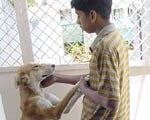Children who grow up with a dog in the house are at a higher risk of developing asthma if they're also exposed to secondhand smoke or nitrogen dioxide.

Most studies of asthma in children have looked at single risk factors, but in the real world, people often face multiple exposures. To investigate the interplay between such exposures, researchers from Canada looked at 380 children at high risk for asthma who had been followed since infancy. The children were considered to be at high risk because they had at least one close relative with asthma, or at least two close relatives with allergies. The children and their families had been participating in a study of whether reducing exposure to potentially allergy-promoting factors, such as household dust and secondhand smoke, might reduce their risk of developing asthma or allergies.
The researchers compared children's exposure to dog allergens, secondhand smoke (measured by checking their urine for the nicotine byproduct cotinine, as well as their umbilical cord blood at birth), and nitrogen dioxide, which is found in automobile exhaust and produced by other types of fuel burning.
At age 7, 71 of the children (19 percent) had asthma, while 141 (almost 41 percent) had bronchial hyperreactivity - twitchy airways in which the tiny tubes of the airways tighten up more intensely in response to a given stimulus (for example, cold air) than they would in a person without the condition, causing difficulty in breathing.
It was found that owning a dog was the only factor that independently increased asthma risk; individual exposure to air pollutants didn't up the risk. However, combinations of exposures did sharply increase risk. For example, 7-year-olds exposed to dogs in infancy as well as to nitrogen dioxide were 4.8 times as likely to have asthma as children with neither exposure, while the combined risk for dog and secondhand smoke exposure was 2.7 times greater. The risk with multiple exposures was even greater for the subset of children who had atopy - the inherited tendency to develop allergic illness, such as eczema, hay fever or asthma; and for these children, early exposure to secondhand smoke alone tripled risk of bronchial hyper-responsiveness.
While the exact mechanism through which these exposures could increase asthma risk isn't known, gas and particles could damage the lining of the airways and trigger inflammation, noted the researchers.
DoctorNDTV is the one stop site for all your health needs providing the most credible health information, health news and tips with expert advice on healthy living, diet plans, informative videos etc. You can get the most relevant and accurate info you need about health problems like diabetes, cancer, pregnancy, HIV and AIDS, weight loss and many other lifestyle diseases. We have a panel of over 350 experts who help us develop content by giving their valuable inputs and bringing to us the latest in the world of healthcare.












